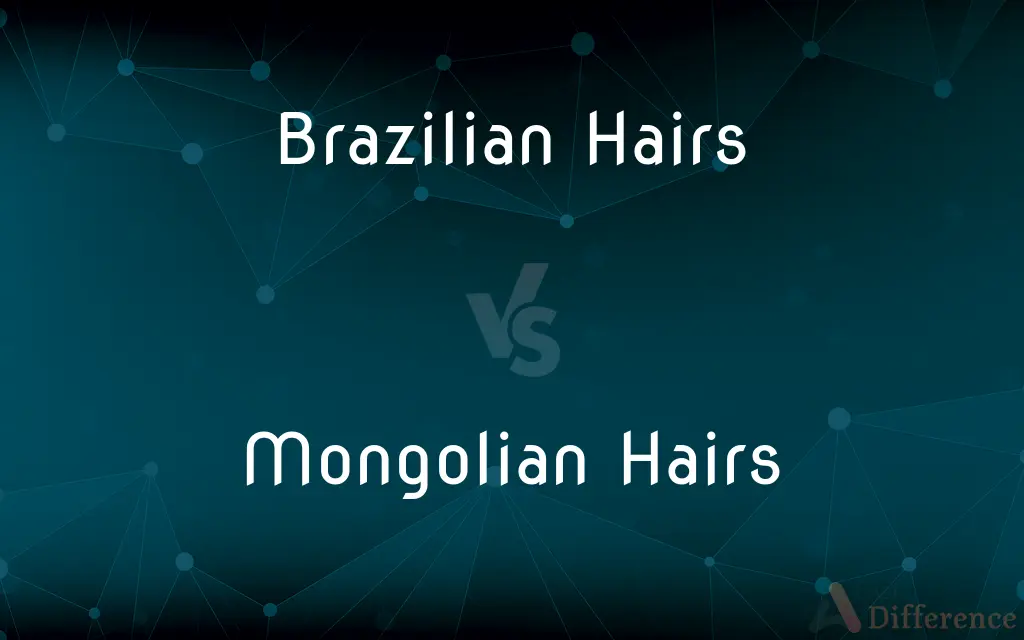Brazilian Hairs vs. Mongolian Hairs — What's the Difference?
Edited by Tayyaba Rehman — By Urooj Arif — Published on March 2, 2024
Brazilian hair is known for its durability, thickness, and ability to blend well with many hair textures, while Mongolian hair is lighter, softer, and has a finer texture, making it a versatile choice for those seeking a more natural feel.

Difference Between Brazilian Hairs and Mongolian Hairs
Table of Contents
ADVERTISEMENT
Key Differences
Brazilian hair is celebrated for its strength, natural shine, and versatility, often recommended for those looking to achieve voluminous styles. It can handle various treatments and styling without losing its texture. Mongolian hair, on the other hand, is prized for its fine texture and softness, offering a more subtle volume and blending seamlessly with finer hair types.
Due to its density and texture, Brazilian hair is less prone to frizz and can maintain styles for a longer duration, making it suitable for diverse climates. Mongolian hair is extremely lightweight and can sometimes struggle with holding styles in humid conditions, yet its adaptability makes it ideal for those seeking comfort and a natural look.
Brazilian hair extensions are often available in a wide range of textures, from straight to curly, catering to a broad audience. Mongolian hair tends to have a more limited variety, typically presenting in straight or slight waves, which mirrors the natural hair texture of the Mongolian population.
The durability of Brazilian hair means it often comes with a higher price tag, reflecting its longevity and the lesser need for frequent replacements. Mongolian hair is slightly more affordable but requires careful maintenance to prolong its lifespan, given its finer nature.
Both Brazilian and Mongolian hairs are excellent choices for extensions, wigs, and weaves. The decision between the two often comes down to personal preference, desired style, and budget, with Brazilian hair favoring those looking for volume and resilience and Mongolian hair appealing to those desiring lightness and a soft texture.
ADVERTISEMENT
Comparison Chart
Texture
Thick, durable, and versatile
Light, soft, and fine
Volume
High volume and density
More natural, subtle volume
Style Retention
Excellent in various climates, less prone to frizz
Holds styles well but may struggle in humidity
Variety
Wide range of textures available
More limited in variety, often straight or slightly wavy
Price
Generally higher due to durability and versatility
Slightly more affordable but requires careful maintenance
Suitability
Ideal for voluminous styles and blending with many hair types
Best for those seeking a lightweight, natural feel
Maintenance
Lower maintenance, resilient to treatments
Requires gentle care to maintain softness and prevent tangling
Compare with Definitions
Brazilian Hairs
Known for its thickness and versatility in styling.
Brazilian hair is my go-to for a full-bodied, voluminous look.
Mongolian Hairs
A cost-effective option for fine hair textures.
Mongolian hair is a great choice for those wanting quality extensions on a budget.
Brazilian Hairs
Ideal for long-lasting wear and frequent styling.
Brazilian hair can withstand a lot of styling without losing its texture.
Mongolian Hairs
Suitable for those looking for a natural, subtle volume.
She chose Mongolian hair for a more understated, natural look.
Brazilian Hairs
Offers a wide range of textures to match various hair types.
You can find Brazilian hair in curly, wavy, or straight textures.
Mongolian Hairs
Offers a softer, more natural appearance.
Mongolian hair is perfect for those who want extensions that feel as light as their own hair.
Brazilian Hairs
Resilient against environmental factors, maintaining style.
Her Brazilian hair extensions stayed sleek despite the humidity.
Mongolian Hairs
May require more maintenance in humid climates.
I have to use extra product to keep my Mongolian hair extensions from frizzing in the moisture.
Brazilian Hairs
Slightly more expensive due to its high quality.
Brazilian hair is worth the investment for its durability and natural appearance.
Mongolian Hairs
Characterized by its fine texture and light weight.
Mongolian hair blends seamlessly with my natural hair, giving it a soft, lightweight feel.
Common Curiosities
Which hair type is better for a humid climate?
Brazilian hair is better suited for humid climates due to its frizz resistance and style retention.
Can Mongolian hair be styled with heat?
Yes, but it requires careful heat management to avoid damage due to its finer texture.
How long do Mongolian hair extensions last?
With proper care, Mongolian hair extensions can last several months, although they may not last as long as Brazilian hair due to their finer texture.
Is Brazilian hair suitable for all hair types?
Brazilian hair is highly versatile and can blend well with many hair types, especially those looking for added volume.
Why is Brazilian hair often more expensive than Mongolian hair?
The cost reflects Brazilian hair's durability, versatility in styling, and ability to maintain its quality over time.
Which hair type is easier to maintain?
Brazilian hair is generally easier to maintain due to its resilience, while Mongolian hair requires more delicate handling.
Are there ethical concerns with purchasing human hair extensions?
Ethical sourcing is a concern in the hair industry; it's important to purchase from reputable suppliers who ensure fair practices.
Can Mongolian hair be used for thick hair looks?
While possible, Mongolian hair is typically sought after for its natural, lightweight appearance rather than for creating voluminous styles.
Can I dye Mongolian hair extensions?
Yes, Mongolian hair can be dyed, but it's important to follow proper dyeing procedures to maintain the hair's integrity.
Is Brazilian or Mongolian hair better for sensitive scalps?
Mongolian hair might be preferable for sensitive scalps due to its lighter weight and softer texture, reducing strain on the scalp.
Share Your Discovery

Previous Comparison
Energy Efficiency vs. Energy Conservation
Next Comparison
Chain of Command vs. Span of ControlAuthor Spotlight
Written by
Urooj ArifUrooj is a skilled content writer at Ask Difference, known for her exceptional ability to simplify complex topics into engaging and informative content. With a passion for research and a flair for clear, concise writing, she consistently delivers articles that resonate with our diverse audience.
Edited by
Tayyaba RehmanTayyaba Rehman is a distinguished writer, currently serving as a primary contributor to askdifference.com. As a researcher in semantics and etymology, Tayyaba's passion for the complexity of languages and their distinctions has found a perfect home on the platform. Tayyaba delves into the intricacies of language, distinguishing between commonly confused words and phrases, thereby providing clarity for readers worldwide.
















































